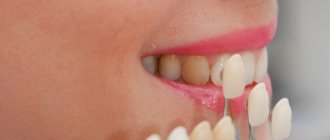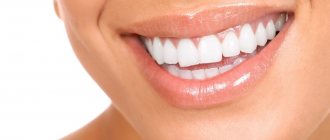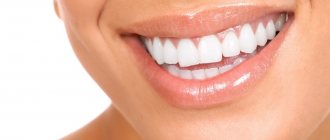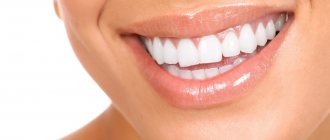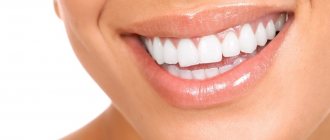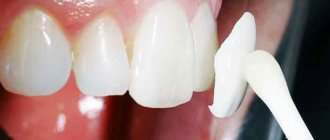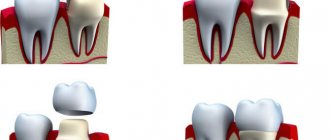Modern dentistry allows not only to treat oral diseases, but also to improve the aesthetic appearance of teeth. In other words, make your smile beautiful. The Denta-Professional clinic offers a wide range of aesthetic dentistry services.
We use only modern working methods, high-quality certified materials, and our offices are equipped with the latest equipment. Over our 21 years of existence, we have helped thousands of people gain a beautiful smile and self-confidence.
Aesthetic dentistry is a direction in dental practice, the task of which is to eliminate various defects in the appearance of teeth and dentition. According to modern beauty standards, the dentition should be smooth, and the dental units themselves should be a natural white color, with microrelief and a transparent cutting edge.
Types of aesthetic dentistry
Depending on the aesthetic task, approaches to work may be different. If a complete change in the appearance of the entire dentition is required, then usually one procedure cannot get rid of it. Complex work of several specialists will be required: gnathologist, orthodontist, surgeon and orthopedist.
If we are talking about less global changes, for example, the restoration of one or more destroyed units, chipped front teeth or changing the appearance of the smile area, the following procedures may be used:
- Restoration with composite materials
- Restoration of chewing teeth with inlays
- Aesthetic (artistic) restoration of anterior teeth
- Aesthetic restoration with veneers
Teeth whitening also falls within the scope of aesthetic dentistry.
Dental restoration as part of aesthetic dentistry
The peculiarity of cosmetic aesthetic dentistry is that it is used to improve the attractiveness of the teeth. In other words, procedures such as eliminating defects in the form of giving the dental composition an identical length, color and shape are carried out.
Important : This type of dentistry allows you to eliminate gaps between teeth and disguise old and incorrect fillings. Thanks to the use of modern materials, it is quite possible to restore the optimal condition of all teeth at once and very quickly.
Restoration with composite materials
To restore the coronal part, dentists use composite light-curing materials, the same ones used for fillings. This procedure is usually used when a tooth with minor damage needs to be restored. The composite material is quite fragile and will not be able to fully restore functionality on chewing teeth if the chip is large.
The service life of such a restoration is individual for each patient and depends on the structural features of his teeth and physiological properties. Bad habits and oral care also have a big impact. The average lifespan of a light seal is 5 years, but it often lasts much longer.
Dental orthopedics as part of aesthetic dentistry
Orthopedic dentistry is a branch of aesthetic dentistry. By contacting an orthopedic dentist, you can undergo:
- diagnostics;
- removal of pathologies;
- elimination of diseases or injuries, including their consequences, of the dental system.
Important: Thanks to modern prosthetic methods, it is possible to fully restore the functions for which the dental system is responsible, for example, speech, consumption and chewing of food. In addition, you can return the smile to its proper appearance and the person’s self-confidence.
Orthopedic methods
In order for dental orthopedics to be carried out to the highest possible quality, you should contact only qualified specialists who can provide competent services and a quality guarantee. There are 4 main methods of smile restoration.
- The use of prosthetics on implants is carried out using special types of implants made from absolutely safe biocompatible material. Thus, the tooth is restored from the root system if it is completely lost.
- This type of aesthetic prosthetics is required for long-term restoration of dental crowns, as well as to correct the shape and color of the teeth.
- A type of fixed prosthetics is the use of crowns, bridges and inlays.
- Removable dentures can be partial or complete, and are used in the complete or partial absence of teeth.
The most important thing is not only aesthetics, but also the correctness of the procedure, as this affects the health of the entire oral cavity.
Artistic restoration of anterior teeth using composite materials
The same procedure as conventional restoration, but performed in the visible area of the smile. It requires the dentist to work much more carefully on the appearance. If in the case of restoration of a chewing tooth one color and material are used, then when it is necessary to remove a chip on the front tooth, the dentist must repeat the adjacent dental units in detail so that the restored tooth does not stand out.
The natural appearance of dental units is partial transparency, heterogeneity and microrelief. This effect can only be achieved using materials of several colors. When performing this procedure, the therapist, like a sculptor, restores the tooth, layer by layer applying different materials. Therefore, such restoration is called artistic.
Indications for aesthetic dental restoration
- chips, fractures and cracks of enamel resulting from injuries;
- discoloration of teeth, appearance of stains;
- the need to replace old fillings made from materials of previous generations;
- increased wear of enamel due to bruxism or malocclusion;
- correction of interdental spaces;
- defects in the location of the tooth relative to other units;
- partial destruction of hard tissues;
- violation of the shape and size of individual teeth;
Dental restoration with veneers
Veneers are thin shells that are glued to the tooth and can improve the aesthetic appeal of the dentition. Restoration with veneers is, in fact, prosthetics performed by an orthopedic dentist. Various types of veneers can be used for the procedure:
- from composite materials (therapeutic or composite materials)
- ceramic (orthopedic);
Veneers made of composite materials. These are plates made of a material similar to that from which fillings are made. Only in the case of veneers does production take place entirely in the factory. Already in the patient's mouth, each veneer is individually adjusted to the tooth. This can also be done by a general practitioner, which is why they are otherwise called therapeutic veneers. In our clinic we offer the best composite veneers from the Swiss company Colten.
Ceramic veneers . The best option for aesthetic restoration in the smile area. They are made in the laboratory individually for the patient’s teeth from durable ceramics. At the same time, they have the most natural appearance. Ready-made ceramic veneers look like “natural” teeth, so it is almost impossible to recognize them visually. Their service life is long - on average it is 20 years. Of course, ceramic veneers are more expensive than composite veneers. However, it is ceramics that provide ideal dental aesthetics and long-term results.
Problems that aesthetic dentistry is designed to solve
Modern techniques allow us to solve a number of serious cosmetic problems that determine the beauty of the patient’s teeth. Thanks to them, it is possible to eliminate defects of various kinds: both congenital and acquired. These include:
- chipped tooth enamel;
- dark spots on it;
- crooked teeth;
- deficiency of dental crown height;
- her serious injuries;
- unsightly teeth shape;
- lack of their whiteness.
Restorations carried out within the framework of aesthetic dentistry provide excellent results: the dentition looks perfect, the gums are healthy, and the enamel is dazzlingly white. CELT estheticians have in their arsenal techniques that allow:
- eliminate stains on tooth enamel, change its color to a lighter color by whitening;
- restore the coronal part after traumatic damage;
- eliminate excessively wide gaps between teeth by installing veneers;
- straighten your teeth by wearing special mouth guards and aligners;
- correct the consequences of teeth grinding (bruxism);
- adjust the length, width, shape of the dental unit.
The results cannot but please you: straight, white, strong teeth, along with a full restoration of their functionality. It is worth noting that the procedures performed in our aesthetic dentistry clinic will not cause discomfort due to the use of gentle but effective anesthetics.
Stages of restoration with ceramic veneers
- Preparatory. The dentist performs the procedure of taking an impression of the existing dentition.
- Based on the bite, a technician in the laboratory creates a plastic model of future teeth, which is tried on the patient.
- If the patient is satisfied with the appearance of the teeth and the way they fit in the mouth, the technician makes ceramic veneers.
- Then, after grinding the patient’s teeth, the veneers are permanently bonded to the surface of the teeth.
After installation of veneers, there is no expected recovery period. The first few days the patient may feel slight discomfort due to the pads, but this quickly passes. A prerequisite for patients with veneers is regular oral hygiene and preventive examinations by the dentist.
Artistic dental restorations at CELT
One of the areas of aesthetic dentistry that solves the problem of restoring the aesthetics of incisors, canines, premolars and molars. Since the latter ensure chewing of food, the procedure becomes functional and aesthetic. The times when dentists installed unsightly fillings and dentures that clearly stood out in the mouth and differed from the natural dental tissues have long since sunk into oblivion. Today they have been replaced by restorations that can effectively replenish the lost volume of tissue and imitate it so accurately that it is impossible to notice the difference.
The variety of techniques used allows us to solve any problem: from correcting the imperfect shape of units, their uneven edges, narrowness or curvature to restoring large volumes of tissue. The process uses composite polymers that have the necessary characteristics both in terms of their aesthetics and their strength and ability to withstand intense loads. Depending on the situation, restorations can be carried out:
- Direct method - directly in the patient’s oral cavity for one to two hours during one visit to the dentist. The service life of such a restoration can be up to ten years;
- Indirect way - with taking an impression and making it in a dental laboratory. Provides perfect results with excellent aesthetic characteristics.
CELT dentists strictly follow technological steps and use high-quality materials, so their restorations cannot be distinguished from natural teeth. They are absolutely identical in color, and their shape is recreated taking into account the anatomical features of natural teeth. By running the tongue over an already installed restoration, the patient will not be able to feel the filling and identify a foreign body when the jaws are tightly closed. The latter is important for the health of the temporomandibular joint.
What are lumineers and how are they different from veneers?
Many people have heard about Lumineers, but few know what it is. Essentially, these are the same veneers, only manufactured at a factory in the USA. Lumineers is a brand of an American manufacturer that has become a household name, like Pampers or Xerox. And it is often used by dishonest dentists to promote conventional veneers. No one can make lumineers for you; they can only be ordered in the USA. We do not work with this product because, in our opinion, it is not ideal aesthetically. In appearance, such ceramics resemble sanitary ware. Making porcelain veneers in a laboratory will be much cheaper and the results will be more attractive.
Dental restoration with inlays
Inlays are microprostheses that restore the destroyed part of the chewing tooth. The inlay is made from an impression and then installed in the desired location. This is a more modern and durable method than restoration with composite material. The inlay is made of ceramic or zirconium dioxide and allows you to completely restore the functionality of the chewing tooth.
Indications for installation of a restoration tab:
- the surface of the molar is affected by caries;
- the molar is destroyed by more than 1/3;
- pathology, as a result of which the patient experiences increased abrasion of the enamel.
How dental restoration is done: from preparation to final processing
- First comes a set of preparation activities. The doctor carries out hygienic prevention of the oral cavity, cleaning the dental covering from plaque and tartar using an Air Flow ultrasonic device. The natural color of the patient’s tooth enamel is determined using a tint scale, and then the appropriate color of the photopolymer composite is selected.
- If there is a need for this, tissue preparation is carried out: removing old filling material, drilling out areas affected by caries. Restorative measures are impossible without first eliminating existing dental problems.
- A latex scarf or rubber dam is required, which isolates the oral cavity from saliva and moisture. The penetration of moisture between the tooth surface and the restorative material will lead to the formation of carious lesions and destruction of the structure under the influence of daily loading processes. If more than half of the tooth is missing, a pin is placed for strength.
- The next stage is treating the tooth coating with etching gels, applying an adhesive layer to ensure gluing of the material and dental tissues.
- To restore a dental crown, a technique is used to apply layer-by-layer composite material of various shades to the surface of the tooth. This method allows the tooth to look natural without standing out from the rest.
- The final stage includes introducing the tooth into the bite, modeling the final shape using grinding and polishing tools, in particular removing irregularities and adding shine.
"Denta-Professional" - we work to make you smile
Our clinic has existed since 1999. We solve any dental problems, regardless of their complexity. "Denta-Professional" is:
- Professionals with experience. We employ only highly qualified doctors who regularly undergo advanced training courses and master new working methods.
- Safety. We carefully comply with all existing sanitary standards to provide our patients with the best conditions. All reusable instruments are disinfected, and disposable ones are disposed of after use.
- Individual approach. We select the course of treatment, the necessary materials, and anesthesia based on the physiological characteristics of the patient. It is important to us that any procedure is not only successful, but also effective.
- Guarantees. We provide a guarantee of up to 5 years for the work we perform. If during the warranty period anything happens to the installed fillings or other materials, we will repeat the procedure free of charge.
Sign up for a consultation now.
